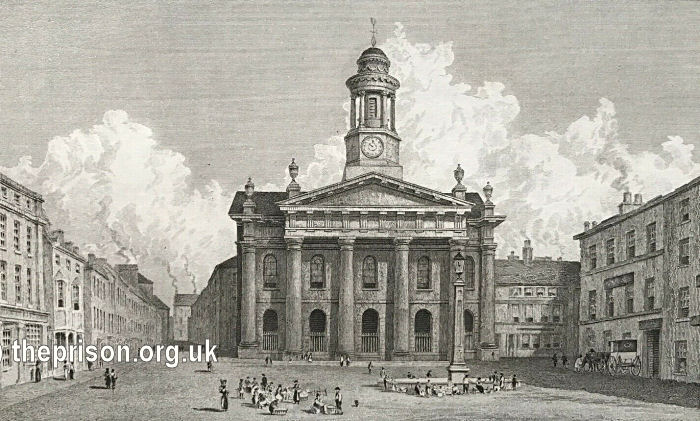Borough Gaol, Lancaster, Lancashire
A Borough Gaol was established in Lancaster in 1782, as part of the new Town Hall and Sessions House buildings on Market Square. A gaol probably also formed part of the previous Town Hall, erected in 1669.
The new gaol was essentially no more than a lock-up, comprising a single room measuring 15½ feet by 11½, in which there was a window and fire-place.
In 1812, James Neild wrote:
This temporary place of confinement is a room under the stair-case of the Town Hall, in size, 15 feet 8 inches by 11 feet 5, and 8 feet 10 inches high . It has a fire-place, with a window about 3 feet square, and contains two barrack bedsteads.
The door has an aperture 12 inches square: and over it, on a stone Tablet, is inscribed, "Executio Juris nulli facit Injuriam. 1669."
Prisoners are sent hither before examination. When a Debtor is taken in custody on a Borough Process, the Officer is under the necessity of keeping his Prisoner in the Town Sergeant's house, until the business is settled.

Session House, Lancaster, 1828.
A second room was subsequently added to the gaol as reported by the Inspectors of Prisons in 1837:
This prison, or rather lock-up, for it is no more, adjoins the Town-hall, and consists of two rooms, deficient in light and ventilation.
No. 1 cell, 24 ft. by 12 ft. 6 in.
No. 2 cell, 15 ft. 9 in. by 11 ft. 3 in.
There are privies in each of the rooms. No airing-yards are attached, nor does any individual sleep on the premises. Prisoners under criminal charges remain here only while under examination. There is a Court of Pleas for the borough, and debtors both under mesne process and in execution are confined here. One debtor, in 1833, remained here for two months; another, in 1835, for 13 weeks; and a third, in 1836, for 14 days. This place is entirely unsuitable for imprisonment of any duration, and particularly for such a class of prisoners as debtors, who are here mixed with disorderlies and prisoners under criminal charges. The town Serjeant acts as keeper, and attends to the wants of the prisoners during the day, salary, 4l. The corporation are fully satisfied of the insufficiency of this lock-up as a place of confinement for debtors, and would willingly contract with the county magistrates for the maintenance of such prisoners in the Castle, but the latter being extra-parochial, and not within the borough, there are legal difficulties in the way of such an arrangement. I have to repeat, that it is a most improper place for the imprisonment of debtors.
In line with the Inspectors' views, the gaol appears to have ceased operation not long afterwards.
The old Town Hall building now houses the Lancaster City Museum.
Records
Note: many repositories impose a closure period of up to 100 years for records identifying individuals. Before travelling a long distance, always check that the records you want to consult will be available.
- No individual records identified for this establishment — any information welcome.
- The National Archives, Kew, Richmond, Surrey, TW9 4DU. Has a wide variety of crime and prison records going back to the 1770s, including calendars of prisoners, prison registers and criminal registers.
- Find My Past has digitized many of the National Archives' prison records, including prisoner-of-war records, plus a variety of local records including Manchester, York and Plymouth. More information.
- Prison-related records on
Ancestry UK
include Prison Commission Records, 1770-1951
, and local records from London, Swansea, Gloucesterhire and West Yorkshire. More information.
- The Genealogist also has a number of National Archives' prison records. More information.
Bibliography
- Higginbotham, Peter The Prison Cookbook: A History of the English Prison and its Food (2010, The History Press)
- Brodie, A. Behind Bars - The Hidden Architecture of England's Prisons (2000, English Heritage)
- Brodie, A., Croom, J. & Davies, J.O. English Prisons: An Architectural History (2002, English Heritage)
- Harding, C., Hines, B., Ireland, R., Rawlings, P. Imprisonment in England and Wales (1985, Croom Helm)
- McConville, Sean A History of English Prison Administration: Volume I 1750-1877 (1981, Routledge & Kegan Paul)
- Morris, N. and Rothman, D.G. (eds.) The Oxfod History of the Prison (1997, OUP)
- Pugh R.B. Imprisonment in Medieval England (1968, CUP)
Links
- Prison Oracle - resources those involved in present-day UK prisons.
- GOV.UK - UK Government's information on sentencing, probation and support for families.
Except where indicated, this page () © Peter Higginbotham. Contents may not be reproduced without permission.



